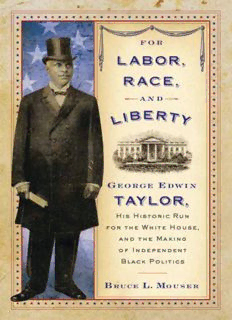
For Labor, Race, and Liberty: George Edwin Taylor, His Historic Run for the White House, and the Making of Independent Black Politics PDF
Preview For Labor, Race, and Liberty: George Edwin Taylor, His Historic Run for the White House, and the Making of Independent Black Politics
For Labor, Race, and Liberty For Labor, Race, and Liberty George Edwin Taylor, His Historic Run for the White House, and the Making of Independent Black Politics Bruce L. Mouser The University of Wisconsin Press Publication of this volume has been made possible, in part, through support from the AF C L S at the University of Wisconsin–Madison. The University ofWisconsin Press 1930 Monroe Street, 3rd Floor Madison, Wisconsin 53711–2059 uwpress.wisc.edu 3 Henrietta Street London WC2E 8LU, England eurospanbookstore.com Copyright © 2011 by Bruce Mouser Allrightsreserved.Nopartof thispublicationmaybereproduced,storedinaretrievalsystem, or transmitted,inanyformatorbyanymeans,digital,electronic,mechanical,photocopying, recording,orotherwise,orconveyedviatheInternetoraWebsitewithoutwrittenpermission of the University of Wisconsin Press, except in the case of brief quotations embedded in critical articles and reviews. 1 3 5 4 2 Printed in the United States ofAmerica Library ofCongress Cataloging-in-Publication Data Mouser, Bruce L. For labor, race, and liberty: George Edwin Taylor, his historic run for the White House, and the making ofindependent black politics / Bruce L. Mouser. p. cm. Includes bibliographical references and index. ISBN 978-0-299-24914-4 (pbk.: alk. paper) ISBN 978-0-299-24913-7 (e-book) 1. African American presidential candidates—Biography. 2. African American politicians—19th century—Biography. 3. African American politicians—20th century—Biography. I. Title. E185.97.T39M68 2011 324.2092—dc22 [B] 2010011577 Contents List ofIllustrations vii Preface ix Acknowledgments xix List ofAbbreviations xxiii Introduction 3 1 From Orphaned Black to Printer’s Devil: Taylor’s Early Years in “God’s Country” 14 2 Labor Agitator, Newspaper Editor, and Political Novice: Schools of Hard Knocks 28 3 Emergence of a Black Activist: Succeeding in the African American World 57 4 Taylor as the National Democrat: Black and Equal 86 5 Taylor’s Campaign to Become President: A Duty to Himself and His Race 107 6 Escape to a Warm Place: Retreat and Reconstruct 135 Conclusion 146 Appendix A: Taylor’s Interview with the Sunafter the 1904 Election 155 Appendix B: Election Data for Nine Political Parties and Candidates in the 1904 Election 159 Appendix C: Chart ofGeorge Edwin Taylor’s Life 161 Notes 167 Bibliography 219 Index 241 v Illustrations Bird’s-eye view of La Crosse, Wisconsin, 1887 9 Nathan Smith 17 Marcus “Brick”Pomeroy 20 “Buffalo Bill”Cody and “White Beaver”Powell 26 John Q. Adams 61 T. Thomas Fortune 65 William Calvin Chase 69 Hon. Frederick Douglass 72 Booker T. Washington 79 William T. Scott 97 George Edwin Taylor, 1904 121 George Edwin Taylor, 1904 presidential poster 126 W. E. B. Du Bois 133 vii Preface Frequently when I was introduced as one ofthe Presidential candidates, I saw people pass the wink around. They didn’t think I saw it, but I want to tell you the colored man is beginning to see a lot of things that the white folks do not give him credit for seeing. He’s beginning to see that he has got to take care ofhis own interests, and what’s more, that he has the power to do it. George Edwin Taylor, interview given to the Sun(New York City), 20 November 1904 In 1904 an African American who was a longtime resident of Wisconsin and Iowa ran for president of the United States. How this came to be is the subject of the present work. George Edwin Taylor’s birth in the slaveholding state of Arkansas in 1857 occurred only five years after the publication of Harriet Beecher Stowe’sUncle Tom’s Cabin, which rallied the nation against an oppres- sive and dehumanizing slaveholding system and propelled the nation toward a civil war that liberated and enfranchised the slaves. Taylor’s political career ended forty-eight years later, in grim contrast, between the publication of Thomas Dixon’s provocative The Leopard’s Spots (1902) and The Clansman (1905), both of which portrayed African Americans as belonging to a physically aggressive and biologically inferior branch of the human race. These novels profoundly shaped America’s attitudes about race and the character of African Americans, and Taylor’s life and interactions with white Americans were influ- enced greatly by them as well. During that half century of change America’s black slave population traveled from a time of bondage to one in which the federal government guaranteed equal voting rights and a degree of integration, then to a phase of stagnation, slippage, and the reemergence of white domi- nance in America’s South, and finally—in full circle—to a time of disenfran- chisement and Jim Crow–inspired racial and physical separation. ix
Description: